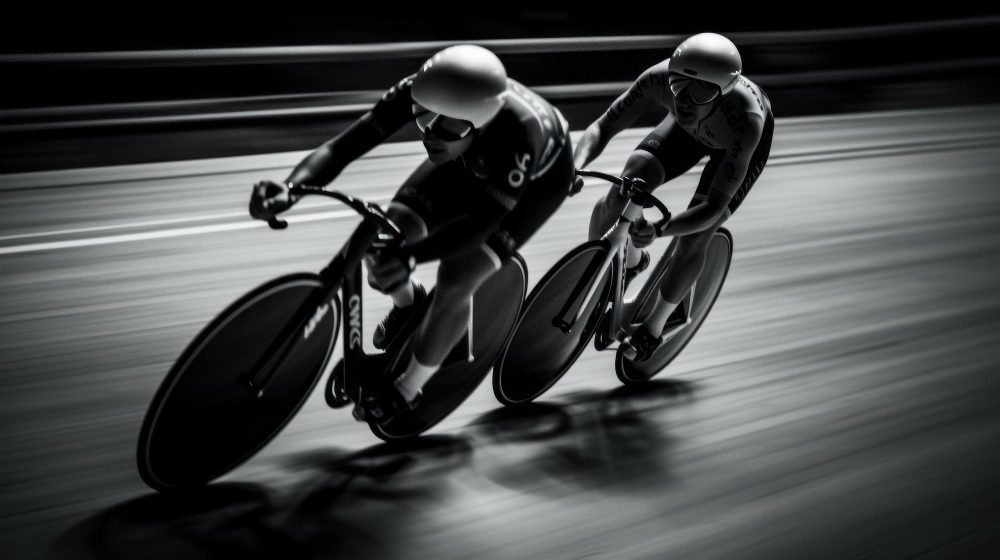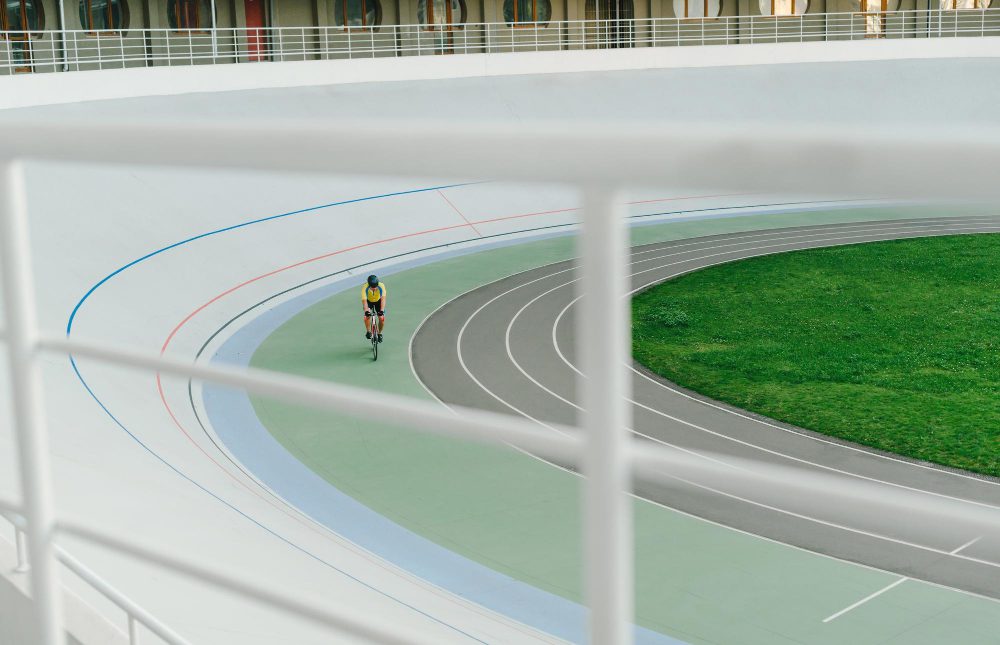How does the velodrome race work?
The velodrome race, also known as track cycling, is a thrilling and fast-paced sport that has gained popularity in the United Kingdom and around the world. With its roots dating back to the late 19th century, this discipline of cycling takes place on a specially designed indoor track called a velodrome. In this article, we will explore how the velodrome race works and the key elements involved in this exciting sport.
The Velodrome Track
Before delving into the specifics of the race, it’s important to understand the structure of the velodrome track. The track is made of smooth wooden boards or a hard composite material, typically measuring 250 meters in length. The track is steeply banked and consists of two straight sections connected by curved bends, enabling cyclists to maintain high speeds throughout the race.
Race Formats
Track cycling offers various race formats, each with its own set of rules and strategies. Some of the most popular race formats include:
- Individual Pursuit: In this race, two cyclists start at opposite sides of the track and aim to catch or surpass their opponent, who is positioned ahead. The race usually covers a distance of 4 kilometers for men and 3 kilometers for women.
- Sprint: The sprint race involves two to four riders competing against each other, covering three laps of the track. The objective is to cross the finish line first or accumulate points based on intermediate sprints.
- Keirin: Originating from Japan, keirin is a highly tactical race where cyclists follow a motor-paced start before racing against each other over several laps.
- Team Pursuit: Four cyclists compete as a team in this race format, aiming to complete a set distance before their opponents. As a team event, cooperation and coordination are crucial.
Rules and Tactics
To ensure fair competition and safety, track cycling has specific rules and tactics that participants must adhere to. Here are some key aspects of the sport:
- No Drafting: Unlike road cycling, drafting or slipstreaming is not allowed in velodrome races. Cyclists must maintain their own pace and position without benefiting from the wind resistance created by another rider.
- Track Standing: In certain race formats, such as the sprint, cyclists may engage in track standing – remaining stationary on their bikes while seeking to outmaneuver their opponents. This tactic requires exceptional balance and bike control.
- Timing: Precise timing is essential in track cycling. Races are often won or lost by mere fractions of a second, prompting athletes to focus on acceleration, speed, and maintaining momentum throughout the race.
“Track cycling requires not only strength and endurance but also tactical awareness and teamwork. It’s a sport that combines strategy with sheer physical prowess.” – British Cycling Champion
The Importance of Teamwork
While individual events are prominent in velodrome racing, teamwork plays a vital role in certain race formats, such as the team pursuit. In these races, teammates work together to maintain a tight formation, taking turns at the front to reduce wind resistance for the entire team. Effective communication and smooth transitions are crucial for success in team-based events.
Closing Thoughts
Track cycling in the velodrome is an exhilarating, high-speed sport that captivates spectators with its thrilling races and strategic maneuvers. With its distinct race formats, rules, and tactics, this discipline of cycling showcases the perfect blend of physical prowess and tactical precision. Whether as athletes or spectators, participating in or witnessing a velodrome race is an experience that embodies the spirit of competition and camaraderie.
What is Track Omnium?
In the world of track cycling, one event that often captures the attention of fans is the track omnium. It is a multi-event competition that tests the endurance, speed, and tactical skills of cyclists in various races over a set period of time.
The Format
The track omnium consists of several different races, with points awarded for each event. The cyclist with the highest total points at the end of all the races is crowned the omnium champion. The specific races included in an omnium may vary, but typically include a combination of mass start, timed events, and individual races.
Some common races in a track omnium include:
- Scratch Race: A mass start race where cyclists aim to be the first across the finish line after a certain number of laps.
- Individual Pursuit: A timed event where cyclists race against the clock to complete a set distance.
- Elimination Race: A race in which the last rider to cross the finish line on each lap is eliminated until the final few riders compete for victory.
- Points Race: A longer race where riders can accumulate points by winning intermediate sprints or lapping the field.
- Time Trial: A timed event where cyclists compete individually to complete a set distance as quickly as possible.
Strategy and Tactics
Track omnium requires not only physical abilities but also strategic thinking. Cyclists need to carefully plan when to push for maximum effort in certain races and conserve energy in others. They must calculate when to launch attacks, when to respond to competitors’ moves, and when to rely on their sprinting abilities.
“The omnium is a true test of an all-around track cyclist. It requires versatility in both endurance and speed, as well as sharp tactical skills.” – Cycling Coach, Sarah Johnson.
Olympic and World Championships
The track omnium became an Olympic event for the first time at the 2012 London Olympics. Since then, it has been a highlight of the track cycling program. Similarly, at the UCI Track Cycling World Championships, the omnium is eagerly contested by top athletes from around the globe.
Winning the track omnium is considered a prestigious achievement in track cycling, and it often showcases the talents of well-rounded cyclists who excel in multiple disciplines.
So next time you’re watching a track cycling event, keep an eye out for the track omnium. It’s a thrilling competition that truly tests a rider’s mettle on the velodrome!
How does the Omnium scratch race work?
The Omnium scratch race is one of the events included in the track cycling Omnium competition. This thrilling race involves multiple riders competing against each other in a fast-paced battle for victory. Here’s a breakdown of how the Omnium scratch race works:
Race Format
The scratch race is typically held on an indoor velodrome and is one of the mass-start events in the Omnium competition. In this race, all participants start together and aim to complete a set number of laps (typically 10-15) first to cross the finish line.
Tactics and Strategies
The Omnium scratch race requires riders to possess both speed and endurance. The race often begins at a high pace as riders jostle for advantageous positions. Riders must strategically conserve energy while staying in contention for the final sprint to the finish line. As cyclists battle for position, tactics such as drafting and attacks come into play.
Scoring System
In the Omnium competition, points are awarded based on riders’ finishing positions in each event. In the scratch race, the winner receives 40 points, while subsequent positions receive fewer points. For example, second place might earn 38 points, third place 36 points, and so on. These points contribute to a rider’s overall score in the Omnium competition.
Quote from a Rider
“The Omnium scratch race is all about being alert, staying tactical, and being able to unleash a powerful sprint when it matters most. It’s a thrilling event that demands both physical prowess and mental agility.” – Professional Cyclist
Key Takeaways
- The Omnium scratch race is a mass-start track cycling event held on an indoor velodrome.
- Riders aim to complete a set number of laps first to cross the finish line.
- Strategies such as drafting and attacks are crucial in this fast-paced race.
- Scoring is based on finishing positions, with the winner receiving the most points.
- The scratch race is just one of the events included in the Omnium competition.
The Omnium scratch race offers an exciting spectacle for both riders and spectators alike. With its emphasis on speed, endurance, and tactics, it showcases the skill and determination of the cyclists competing for victory.
How Many Laps is a Keirin Race?
The Keirin race is a highly competitive and thrilling event that originated in Japan and has gained popularity worldwide, including in the United Kingdom. It is a track cycling discipline that involves sprinting over multiple laps on an oval track. But how many laps does a Keirin race typically consist of?
Understanding the Keirin Race Format
A Keirin race usually consists of several stages before the final sprint to the finish line. The specifics may vary depending on the level of competition and governing bodies, but generally, the race format includes:
- Preliminary Rounds: In this phase, riders are divided into different heats or groups, typically six riders per heat. The number of preliminary rounds can vary, but each heat involves multiple laps.
- Repechages: Riders who didn’t advance directly from the preliminary rounds get another chance to qualify through repechages. These are additional races held for those who finished outside the top positions in their heats.
- Final: The top riders from the preliminary rounds and repechages progress to the final. This is where the champion will be determined, with riders sprinting over a set number of laps to claim victory.
Number of Laps in a Keirin Race
The specific number of laps in a Keirin race can vary depending on the track length and competition regulations. In the UK, Keirin races are typically held on 250-meter velodromes, although some larger venues may have longer tracks.
The length of a standard Keirin race in the UK is often around 2 kilometers or 8 laps on a 250-meter track.
The actual number of laps can be influenced by factors such as the speed of the riders, track conditions, and strategic considerations. Keirin races are known for their tactical nature, with riders jostling for position before unleashing their sprinting prowess in the final lap or two.
Keirin Race Tactics
Within the race, Keirin riders employ various strategies to increase their chances of success. These tactics include:
- Pacing: Some riders prefer to set a moderate pace during the early laps to conserve energy for the final sprint. Others may rely on explosive bursts of speed to gain an advantage.
- Drafting: Riders often try to ride closely behind the lead rider to reduce wind resistance and conserve energy. This tactic is commonly referred to as drafting or slipstreaming.
- Positioning: Securing a favorable position on the track is crucial in Keirin racing. Riders aim to find the best line around corners and strategically position themselves to launch their final sprint.
Overall, Keirin races are dynamic and unpredictable, providing spectators with enthralling displays of speed, skill, and strategy. The number of laps varies depending on the race stage, but the final sprint usually consists of around 8 laps on a 250-meter track. So, next time you watch a Keirin race, pay close attention to the tactical maneuvers and exhilarating sprint finishes!
What is an Omnium for Velodrome?
The Omnium is a track cycling event that involves multiple races held within a single competition. It is a popular and highly competitive discipline in the velodrome, attracting both professional and amateur riders. The Omnium consists of several different races, each focusing on a specific skill set, ultimately determining the overall winner based on aggregate points.
Format of the Omnium
The format of the Omnium varies slightly depending on the level of competition and the governing body. However, it typically includes the following races:
- Flying Lap: A timed race where riders individually complete one lap of the track from a flying start. This race tests speed and endurance.
- Points Race: A longer race where riders accumulate points by winning intermediate sprints and lapping other riders. Strategy and stamina play a crucial role in this race.
- Elimination Race: Also known as the “Devil Take The Hindmost,” this race starts with all riders, and at regular intervals, the last rider crossing the line is eliminated. This race requires both tactical awareness and sprinting ability.
- Individual Pursuit: A race against the clock where riders start on opposite sides of the track and aim to catch or finish with a better time than their opponent. This race tests a rider’s ability to maintain a steady pace and endurance.
- Scratch Race: A mass start race where riders aim to be the first to cross the finish line after a predetermined number of laps. Speed, tactics, and positioning are essential in this race.
- Time Trial: A race against the clock where riders complete a set distance individually. This race focuses on pure speed and aerodynamics.
The Scoring System
The scoring system for the Omnium is based on the finishing position in each race. The winner of each race receives one point, the second-placed rider gets two points, and so on. At the end of all the races, the rider with the fewest points is declared the overall winner.
“The Omnium is the ultimate test of versatility and all-round ability for track cyclists.” – Cycling Federation
Due to its demanding nature, the Omnium requires riders to have a wide range of skills, including sprinting, endurance, tactical awareness, and time trialing ability. It rewards versatility and consistency, making it a thrilling event for both riders and spectators in the velodrome.
If you are a track cycling enthusiast or looking to try your hand at competitive cycling, the Omnium is a challenging and exciting event that pushes riders to their limits. With its unique combination of races and scoring system, the Omnium showcases the best all-round cyclists and highlights the importance of adaptability and strategy in velodrome racing.
How many riders in a Keirin race?
Keirin is a thrilling track cycling event that originated in Japan and has gained popularity worldwide. In a Keirin race, a group of cyclists compete against each other in a fast-paced sprint to the finish line. The number of riders in a Keirin race can vary depending on the specific rules and regulations of the event.
Keirin Race Structure and Regulations
In general, a Keirin race usually consists of between 6 to 9 riders. The exact number of participants can depend on various factors, including the racing venue and the level of competition. For example, an international Keirin race may have a larger field with more riders compared to a local or regional event.
Each Keirin race follows a specific set of rules to ensure fair competition and safety for all riders. Riders start the race behind a pacing motorbike, known as a derny, which gradually increases speed before exiting the track. Once the derny leaves the track, the riders then sprint to the finish line.
Importance of Rider Positioning
In Keirin racing, rider positioning plays a crucial role. Since the race is relatively short, usually lasting around 2 kilometers, riders aim to strategically position themselves behind their opponents to take advantage of slipstreaming – riding in the draft created by the rider in front. This tactic helps conserve energy and allows riders to make a powerful surge towards the finish line in the final moments of the race.
“Keirin racing requires not only speed and power but also tactical decision-making and anticipation.”
Other Interesting Facts about Keirin Racing
- Keirin racing was introduced in Japan in 1948 as a way to gamble on track cycling events.
- Today, Keirin races are regulated by the Union Cycliste Internationale (UCI) and governed by strict rules.
- Professional Keirin cyclists often undergo rigorous training and preparation to compete at the highest level.
Overall, Keirin racing is an exciting sport that demands both physical prowess and strategic thinking. Whether you’re a cycling enthusiast or new to the sport, watching a Keirin race can be a thrilling experience, especially when you understand the dynamics of rider positioning and the tactics involved.



